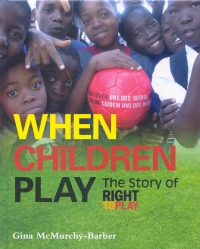| ________________
CM . . .
. Volume XX Number 10. . . .November 8, 2013
excerpt:
“When Children Play, the World Wins!” Such is the motto of Right to Play (RTP), an organization started in refugee camps in Angola and Cote d’Avoire in 2001 in order to help disadvantaged children who don’t often have the opportunity to play, perhaps due to war in their country, gender inequalities or disability. With the help and dedication of thousands of volunteers, coaches, teachers and professional athletes, RTP sets up programs, provides sports equipment, mentors youth and educates children and their families for better health and for peace in the world. It provides a sense of normalcy in an area of the world that is affected by war, starvation or poverty. Educators have long known the benefits of play to learning. Through play, participants learn about sharing, sportsmanship, teamwork, goal setting, negotiating, compromising, skill development and healthy living. Over time, the goal of RTP is to set up programs which eventually can be run by members of the local community, giving them a sense of leadership and instilling confidence. Today, there are more than 15,000 trained volunteer coaches, and the program is delivered to nearly one million disadvantaged kids in almost two dozen countries worldwide. Athlete Ambassadors, such as Wayne Gretzky and Clara Hughes, teach life skills, act as role models, promote the organization, donate sports equipment and assist in fundraising efforts. When Children Play not only provides information about the history of Right to Play, its key goals of healthy living and how participants can become productive members of society, its philosophy, motto, and the symbolism behind the five colors of RTP (which correspond to the five Olympic ring colors), but it also takes an honest look at some of the obstacles to establishing RTP programs. Some of these obstacles include convincing people of the importance of play, volunteer recruitment and gender rules (especially in countries where girls are denied many of the rights afforded boys). In addition, there are text boxes, quotes from famous humanitarians and Olympic athletes, and several “Games to Try” sections. Here, readers will find instructions for very simple and fun games which require very few pieces of equipment. The games build teamwork as well as teach lessons about fair play, and some even provide tools to deal with peer pressure. One of the book’s greatest strengths, however, is McMurchy-Barber’s inclusion of true stories about specific children in various countries and how, despite their predicament, these children are inspired to help other kids. Their world and daily lives are so vastly different from those in Canada, and McMurchy-Barber tells their stories with honesty and compassion. Though circumstances in many of the countries are often dire, the red ball of RTP is a symbol of hope, and the organization’s philosophy, “Look after yourself, look after one another”, is imprinted on every ball, a reminder that when everyone gets involved, big changes can happen to create a brighter future. Color photographs, all suitably labeled, enhance the text. They are printed on carefully chosen backgrounds depicting green grass or brown dirt, perhaps symbolizing that children don’t need elaborate, well-appointed gyms or buildings in which to play simple games. A table of contents, a glossary and an index are provided, as well as a resource list that includes several related web sites and the contact information for the offices of Right to Play International in both Canada and the United States. Ultimately, this well-written and researched book reminds us that we are all part of the global village and responsible for each other. Hopefully, reading When Children Play will spur some readers to social action. Highly Recommended. Gail Hamilton is a former teacher-librarian in Winnipeg, MB.
To comment
on this title or this review, send mail to cm@umanitoba.ca.
Copyright © the Manitoba Library Association. Reproduction for personal
use is permitted only if this copyright notice is maintained. Any
other reproduction is prohibited without permission.
NEXT REVIEW |
TABLE OF CONTENTS FOR THIS ISSUE
- November 8, 2013.
AUTHORS |
TITLES |
MEDIA REVIEWS |
PROFILES |
BACK ISSUES |
SEARCH |
CMARCHIVE |
HOME |
